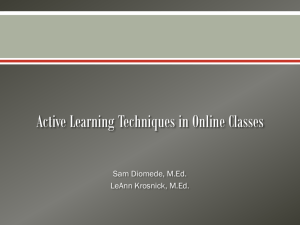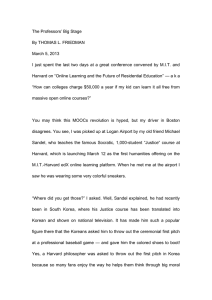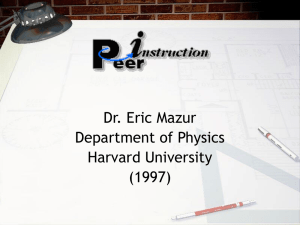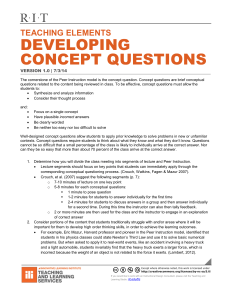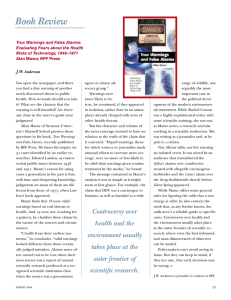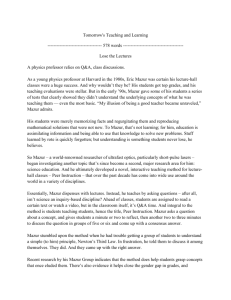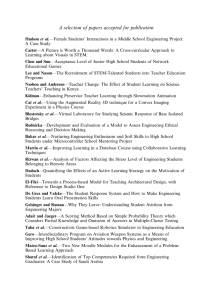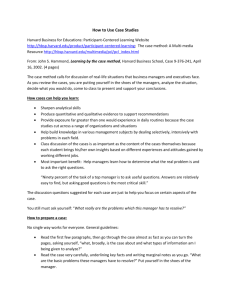Inside the Classroom Practical Teaching Techniques
advertisement
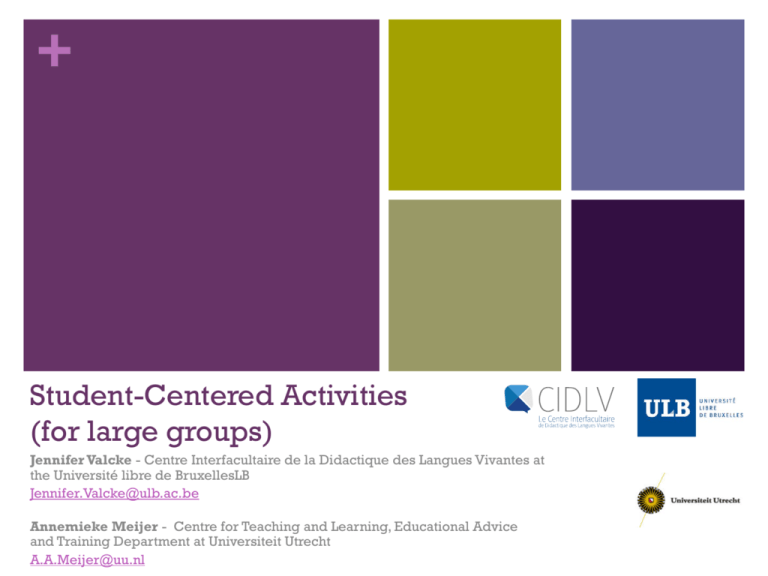
+ Student-Centered Activities (for large groups) Jennifer Valcke - Centre Interfacultaire de la Didactique des Langues Vivantes at the Université libre de BruxellesLB Jennifer.Valcke@ulb.ac.be Annemieke Meijer - Centre for Teaching and Learning, Educational Advice and Training Department at Universiteit Utrecht A.A.Meijer@uu.nl + Who’s Who? Annemieke Meijer Coordinator of the Writing & skills center and tutor at University College Utrecht Jennifer Valcke ESP and EAP teacher at the Engineering School of Brussels at the ULB CLIL advisor – linguistic and pedagogical support for teaching and learning in a foreign language + Let’s Get to Know One Another! In your folders, you will find a list of questions Walk around the room and collect answers from other participants As a group, let’s discuss your findings + What Makes an Effective Teacher? Take a minute to think about: One characteristic of an effective teachers One characteristic of an ineffective teachers Write your answers down on a piece of paper and pass it to Jenny Let’s take a look at your responses together + Bloom’s Revised Taxonomy (Anderson and Krathwohl, 2001) For an interactive model and a complete list of categories, please go to: http://www.celt.iastate.edu/teaching/RevisedBlooms1.html + (Inter)Active Learning Turn to your neighbour and discuss the following: What interactive techniques do/have you use/d in your classes? At the beginning / middle / end of a lecture? Any advantages? Any drawbacks? Now, discuss your ideas with another pair of participants Decide on one activity that you will describe to the rest of the group + Why Active Learning? The lecture is the process by which the notes of the lecturer are transferred to the notes of the student without passing through the mind of either In groups of 4, discuss the above well-known joke Now let’s discuss this as a group + Why Active Learning? Involving students in doing things and thinking about the things they are doing (Bonwell & Eison 1991). Engaging students in: Thinking critically or creatively Speaking with a partner, in a small group, or with the entire class Expressing ideas through writing Exploring personal attitudes and values Giving and receiving feedback Reflecting upon the learning process + Does Active Learning Work? Hake (1998) reported the results of one study involving 62 introductory physics courses (N>6000 students) Springer et al. (1998) similarly reported a large meta-analysis of studies examining small group learning in SMET courses (i.e., Science, Maths, Engineering, and Technology). Dramatic student gains in conceptual and problem-solving test scores Various forms of small group learning produced: Higher achievement test scores, More positive student attitudes, Higher levels of student persistence. Knight & Wood (2005) report the results of a study completed in a large, upper-division Biology lecture course. Students were observed to make significantly higher learning gains and better conceptual understanding when taught with: in-class activities in place of some lecture time, collaborative work in student groups increased in-class formative assessment group discussion + Let’s take a break! + Controversial Questions About Active Learning There are controversial questions posted around the room. Read each statement. If you agree with it, use a green sticker; if you disagree with it, use a red sticker. Place your chosen sticker on the agree-disagree continuum so that it reflects your opinion. Now discuss the results in small groups. + A Few Words on Attention-Span The attention of university students during a 50 minute lecture – where the lecturer lost his audience (Hartley and Davies 1978) + A Few Words on Attention-Span “I decided that every lecture I’d ever give would come in discrete modules. Since the 10-minute rule had been known for many years, I decided the modules would last only 10 minutes.” (Medina 2008) + Interactive Activities Let’s go through a few activities Basic Intermediate Advanced Use the green and red cards in your folders to respond to Jenny’s questions. + Interactive Activities Basic (1/2) Think-pair-share / Think-pair2-share One-minute paper Students must consider a question alone (make notes). Exchange information with their neighbour. (Grouping with another pair to settle on a final answer) 2. Reporting back to the class. Ask students to produce, alone or in pairs, a written response in only one minute. Used to collect feedback on student comprehension. Allows students an opportunity for immediate application. Paired discussions In 3 or 4 minutes, have students discuss something with the person next to them: summarise class so far; react to theory, concepts, or information; relate today’s material to past learning, etc. Make your questions as specific as you can. + Interactive Activities Basic (2/2) Exam question Question of the day Alone / in 2s / in 3s, students write an exam question to do with the topic they have just covered in class (i.e. an open question, a multiple choice question, etc.) Short paired activities for the beginning of class that engage students with the lecture material that requires students to think actively about the content. The question requires short explanations, annotations, calculations, or drawings that develop communication skills as well as higher-level thinking. Concrete images To help students make specific references to a topic, go around the room and ask each one to state a concrete image / scene / event / moment that they find relevant. List these on the board. Ask students to find themes or patterns, missing points, etc. The move the discussion to analysis with a common collection of facts. + Interactive Activities Intermediate (1/3) Demonstrations Multiple choice Effective demonstrations ask students to predict outcomes, experience the demonstrations, and reflect by comparing the prediction and actual outcomes Questions are conceptual multiple choice questions that are used to assess student understanding Students work on the questions individually You could use the voting remotes or green/red bits of paper These questions can be used to promote higher-level thinking such as analysis, critical thinking, and synthesis Role-playing Activities put the student in the position of a relevant decision maker forcing them to apply the content to determine a policy or solve a problem + Interactive Activities Intermediate (2/3) Skeleton Notes Examples of skeleton or partial note handouts or power points slides that maintain intellectual engagement throughout the class. Students must complete partial notes as the lecture progresses. These require an initial investment in terms of preparation, but are then easily available for subsequent semesters. Buzz groups Give one or two prepared questions to groups of 3 to 5 students. Each group records its discussion and reports to the whole class. Help the class summarise the groups’ answers. + Interactive Activities Intermediate (3/3) Truth statements Ask several small groups to decide on 3 things they know to be true about a particular issue. This is useful when introducing a new topic which students think they know well, but where their assumptions need to be examined. Reaction sheet After presenting a controversial topic, pass around several sheets to collect written reactions to these questions. Ask questions like: “What ideas do you questions? What ideas are new to you? What ideas really hit home?” Follow up with discussion. Variations include asking each student to write on a sheet of paper, or ask small groups to do so. + Interactive Activities Advanced (1/2) Value lines Students line up according to how strongly they agree or disagree with a proposition, or how strongly they value something. This gives a visual reading of the continuum of feelings in the group. Next, sort students into heterogeneous groups for discussion. Ask students to listen to differing viewpoints in their groups and to paraphrase opposing positions fairly. Forced debate As students come into the auditorium, ask all students who agree with a proposition to sit on the left and students who oppose it to sit on the right. Hanging signs with the propositions will help. It is important that they physically take a position and that the opposing sides face each other. Once this is done, force them to argue for the position with which they disagree. This activity will allow students to plunge into temporary ownership of viewpoints which are not their own (in opposition to their own strongly held opinions). + Interactive Activities Advanced (2/2) Philips 66 The teacher presents students with a question or a problem. Divide your students into groups of 6 students, and tell them to organise themselves in sub-groups (one student must lead the discussion and another will report the discussion and take notes). Each group spends 2 minutes dividing themselves up in their respective roles. The teacher then gives out the question (each group may have a different or same question) and lets students discuss it for 6 minutes. It is essential for groups to produce a fully-formed sentence (i.e. whose syntax is correct) expressing their ideas or opinions. The reporter must thus note down the group’s response and not individual opinions/ideas. After 5 minutes, the teacher reminds students that “There is 1 minute left) and stops the activity after 6 minutes. The teacher should make sure that students quiet down. Reporters are then invited to the front of the class to read out their notes. The teacher or other students can write these on the board. The teacher may choose to continue with further questions or not, but should ensure that roles are changed every time (i.e. the speaker and the reporter). + Eric Mazur (Harvard) on Interactive Teaching Let’s watch a short video. In groups of 4s, discuss the following: Which methods is Professor Mazur using? Do you see yourself using such techniques in your courses? What would be your greatest challenge? + Eric Mazur (Harvard) on Interactive Teaching View video on: http://www.youtube.com/watch?v=wont2v_LZ1E + Michael Sandel Harvard University’s Justice Let’s watch another short video. In groups of 4s, discuss the following: What techniques is Professor Sandel using? How is he gaining and sustaining student attention? + Michael Sandel Harvard University’s Justice View video on: http://www.justiceharvard.org/2011/03/episode-01/#watch + 10 Things to Remember (1/2) 1. Lecturing is especially useful to convey knowledge, but is not well suited for higher levels of learning. 2. Decide what you want the students to know and be able to do as a result of the lecture. 3. Outline the lecture notes — first your major points, then the minor points that elaborate on or explain each major point. 4. Choose relevant, concrete examples, in advance of the lecture, selecting examples familiar and meaningful to the students. 5. Find out about the students, their backgrounds, and their goals. + 10 Things to Remember (2/2) 6. Permit students to stop you to ask relevant questions, make comments, or ask for review. 7. Intersperse periodic summaries within the lecture. 8. Start with a question, problem, current event, or something that just grabs the students’ attention. 9. Watch the students. If you think they don’t understand you, stop and ask them questions. 10. Use active learning techniques. Use technological aids, such as multimedia presentations + Checklist for Active Learning 1/2 Preparing the course content and lecture Organising the lecture What are the fundamental concepts and/or knowledge that students are expected to gain from this course? What are your students' experiences and background with the subject matter? What is the relationship between the lectures and other course materials? What are the four or five main points the lecture should convey? Presenting the information How will you begin your lecture? What activities are planned and how will you vary the rhythm? What activities will you use to reach students with different learning styles? What materials will you use in giving the lecture? + Checklist for Active Learning 2/2 Delivering the Lecture Are the main points or outline of the lecture written on the overhead or blackboard? Are students aware of the focus of the day's lecture? Are student contributions encouraged and integrated into the lecture? Can students following you comfortably or are they scribbling madly? Can every student see and hear you? Encouraging Active Learning Is the material related to the students' experiences and/or background? How can students demonstrate their involvement in the class? What opportunities do you have to get feedback from students? + References Bonwell and Eison, 1991. “Active learning: Creating excitement in the classroom”. ASHE-ERIC Higher Education Report No. 1. Washington, D.C.: The George Washington University. Crouch et al., 2007. Peer instruction: Engaging students one-on-one, all at once. Reviews in Physics Education Research v.1: Research-based reform of University Physics. Dufresne, Gerace, Leonard, Mestre and Wenk, 1996. Classtalk: A Classroom Communication System for Active Learning. Journal of Computing in Higher Education, v7, p3-47. Hake, 1998. “Interactive-engagement vs. traditional methods: A six-thousand-student survey of mechanics test data for introductory physics courses”. American Journal of Physics, v66, p64-74. Hartley and Davies,1978. “Note taking: A critical review”, Programmed Learning and Educational Technology15, p207-224. Knight and Wood, 2005. “Teaching More by Lecturing Less”. Cell Biology Education, v4, no4, p298-310. King, 1993. “From Sage on the Stage to Guide on the Side”. College Teaching v41 no1 p30-35. Lyman, 1987. “Think-Pair-Share: An expanding teaching technique”. MAA-CIE Cooperative News, 1, 1-2. Mazur, 1997. Peer Instruction: A User's Manual. New Jersey: Prentice Hall. Medina, 2008. Brain Rules, Pear Press: Seattle. Springer et al., 1998. "Effects of cooperative learning on undergraduates in science, mathematics, engineering, and technology: A meta-analysis." (Research Monograph No. 11). Madison: University of Wisconsin-Madison, National Institute for Science Education, Review of Educational Research.
